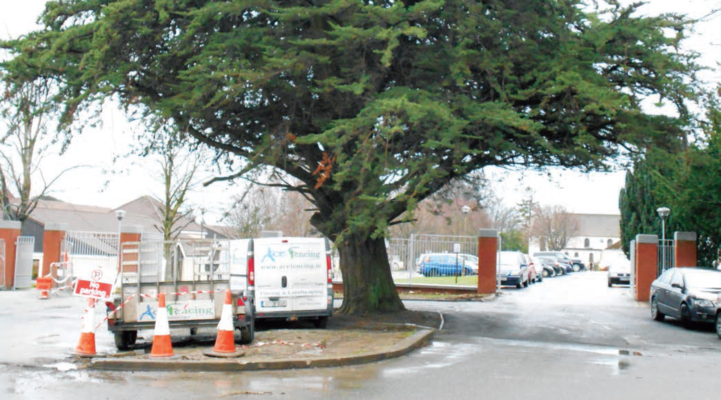Trees and development – same old story? This opinion piece is written by Aidan J ffrench from a personal perspective, formed by the daily experience of the travails of the Irish urban tree and by what passes for official policy in the Republic of Ireland. So, it is written ‘from the trenches’ and therefore reflects a striving to achieve optimal solutions for ‘tree thriving’ (beyond mere survival) in newly built environments. The author would welcome feedback on the issues raised.
Earlier this month the Tree Council of Ireland (TCI) invited us to celebrate ‘The Sound of Trees’, its theme for National Tree Week 2014, a nice homely concept. But as the trees make sounds and dare to speak, what do they say and are we listening to their pleas?
The TCI has often spoken about the need to foster a tree culture in Irish society. While much of the activity of tree advocates is focused, quite understandably, on educating the younger generation, it is arguably the older generation that most needs convincing. I can’t help but think that the pleas of the trees are firmly directed at this generation. After all, it’s the generation that shapes the urban environment where most Irish people live. It uses its power and influence to decide, often unwittingly and incoherently, the fate of urban amenity trees. And in my experience, fostering a tree culture in the development community (developers, builders, architects, planners, engineers etc) of that generation is an urgent, but rewarding, challenge.
For the past year, I’ve become very engaged in the fate of urban trees in their struggles with the Irish planning system. It has been an education, or more accurately a re-education, which started in the early 80s when, as a UCD student, I was first introduced to trees, planning and construction by Dublin County Council Parks Department. It was busy carving out a role in this area, building a working relationship with the Council’s planners.
More than 30 years later it seems the issues are as alive and problematic as ever. Has the fate of urban trees improved? And have trees been adequately addressed in government policy, legislation or regulation, let alone in professional practice? In the limited space available here, I’ve attempted to provide some answers.
“More than 30 years later it seems the issues are as alive and problematic as ever. Has the fate of urban trees improved?”
Having a role in stewarding the fate of urban trees is a daunting and honourable responsibility. Thankfully, things have moved on since the 1980s – there’s more awareness, more and better professional expertise and more tools available, and none more so than the revised British Standard, BS5837:2012 Trees in relation to design, demolition and construction – recommendations. This has, in effect, become the Bible for arborists, landscape architects and local authority parks professionals (where they exist – most authorities and no government department employs them). The BS provides a coherent methodological framework that, when used correctly, can ensure that the fate of trees is sustainably planned. I know, the ‘S word’! Sustainability: over-used and much abused. A definition will help: as it applies to sustaining urban trees on development sites, for me it means applying prudence, feasibility (e.g. realistic appraisal) and forward-thinking (e.g. appropriate species selection) to facilitate quality decision making. The BS is at its best when applied as a design tool to inform the proposed site layout, rather than as a mere, box-ticking exercise for a planning application, after ‘the architect’s horse had bolted’.
Of course, one industry standard does not policy or guidance make. Unfortunately, like so many environmental issues in Ireland, trees in urban areas suffer from a lack of real commitment at national and local levels to adequate financial and human resources. Contrast this with the UK as just one example of more progressive states. 25 years ago I joined the Ealing Borough Council (Parks Department), the ‘Queen of the London boroughs’ so renowned for its dedication to horticulture that the corporate letterhead was and still is an oak tree. In 1989 Ealing not only had three full-time arboricultural officers, but also a computerised tree management system to manage its tree population. 25 years later in Ireland and not one of the 34 city and county councils employ a tree officer (though recently Dublin City Co advertised for one). And only two have computerised tree management software (Dún Laoghaire-Rathdown and Fingal). That’s how far behind we are in Ireland.
SOME SUGGESTIONS FOR MOMENTUM
A couple of simple, progressive initiatives by Minister Phil Hogan could have significant benefits for urban trees. In the short term, he could require all planning authorities to include in their planning application forms an obligation to State if trees are present on the site and if so, to submit a tree survey and impacts assessment with the application. This initiative would only require his signature on a statutory instrument which could be prepared in a matter of days. It would have several immediate benefits, chiefly by focusing on architects’ and planners’ attention on trees early in the development process.
In the medium term, the Minister could introduce far-reaching legal provisions by introducing a statutory obligation on all local authorities to prepare and implement tree strategies. Dun Laoghaire-Rathdown and Fingal councils have already done so. Tree strategies include essential management tools, for as classic management mantra says ‘you cannot manage what you don’t measure’. Along with a requirement for tree strategies, the larger local authorities should be required to employ full-time tree officers to implement the strategies. Of course, all this presupposes a desire by that older generation to manage urban trees as a resource, to see them as essential components of green infrastructure in the first place.
CONCLUSION
So have things really changed for the better? I’m not sure as there’s little readily available evidence upon which to base a considered opinion. That in itself is telling. I remain to be convinced that we’ve truly moved on, at least in any profound or systematic way. For while there’s much lofty, aspirational rhetoric by the State about trees (eg, development plans, guidance documents), too often there are yawning chasms between words and reality, which cannot be explained solely by public sector cutbacks. Because in the final analysis, it is by actions – born of genuine commitment – not words, that judgment on the fate of urban trees will rest.
So, before we engage in another, the foolhardy rush into a building frenzy, isn’t it time to put in place some safeguards for the much beleagured Irish urban tree? Now, why do I feel the need for a conference coming on? Withdrawal symptoms? Well, it seems like a very long time since the industry convened an urban tree conference. It is long overdue. Time to bring builders, developers, arborists, architects, landscape architects, nurserymen, politicians and others together for good listening to the ‘Sound of the Trees’. Anyone out there? ✽
 AIDAN J. FFRENCH MILI Landscape Architect is Past President of The Irish Landscape Institute (ILI) and a member of The Urban Forum (20052009). Aidan is a parks professional working with Dun Laoghaire-Rathdown Parks & Landscape Services in Co Dublin. The views expressed are those of the author alone and not those of Dun Laoghaire-Rathdown Parks & Landscape Services, the ILI or Urban Forum. AIDAN J. FFRENCH MILI Landscape Architect is Past President of The Irish Landscape Institute (ILI) and a member of The Urban Forum (20052009). Aidan is a parks professional working with Dun Laoghaire-Rathdown Parks & Landscape Services in Co Dublin. The views expressed are those of the author alone and not those of Dun Laoghaire-Rathdown Parks & Landscape Services, the ILI or Urban Forum.
He can be contacted at aidan.ffrench@dlrcoco.ie |







